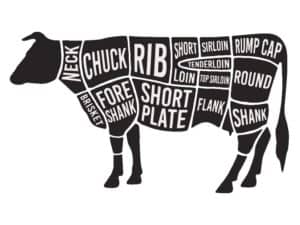Different Types of Beef Cuts

Different Types of Beef Cuts
To truly reap the benefits of buying fresh subprimal cuts of beef from a butcher shop, it is imperative to become familiar with the types of cuts of meat, their qualities, and techniques utilized in cooking them. In doing so, you will likely also develop a deeper appreciation for the complexities of each cut, and a preference for those that cook up nicely.
The Eight Primal Cuts of Beef and Each of Their Subprimal Cuts
Chuck (Seven-Bone Steak)
The chuck is located near the shoulder neck area of the cow. It is also known as the seven-bone steak in reference to the shape of the bone. The chuck yields economical subprimal cuts of beef, including the flat iron steak and chuck roast. Though flavorful, the chuck contains quite a bit of connective tissue and collagen, which can be a bit on the tougher side. Therefore, its best to cook chuck cuts low and slow, which means to use a crock pot or braise the cut on low heat for a long period of time.
Shank
The shank is one of the toughest cuts of beef, as it comes from the leg where the muscle is in constant use. Given the quality, it is quite unpopular and cheap. The shank is often left whole and is best cooked in liquid over a long period of time to make soups, stews, and beef stock.
Brisket
The brisket comes from the breast of the cow and yields the brisket flat cut and the brisket point cut. Though it contains quite a bit of connective tissue, brisket is very popular for barbecue and is especially delicious when smoked or braised.
Rib
The rib is undoubtedly one of the most popular primal cuts and is known for flavor, tenderness, juiciness, and incredible marbling. The rib yields several of the finest subprimal cuts of beef, including the short rib, prime rib, rib-eye steak (bone out and bone in), rib-eye cap steak, and prime rib. To best accentuate the flavors of rib cuts, cook with dry heat, time, and a little bit of patience.
Short Plate
The short plate is located below the ribs on the frontal belly of the cow. It is best to braise cuts from the short plate, as the meat is very fatty and tough. Some of the butcher shop cuts of meat that comes from the short plate include the hangar steak, short ribs, and skirt steak.
Flank
The flank is another very tough cut of meat, as it comes from the abdominal muscles of the cow. The flank is often cut into flank steak or flap steak and is typically used in Mexican cuisine for stir-fry and fajitas. Given its toughness, it is best to cook flank cuts with moist cooking methods like braising.
Loin
The loin is typically sourced from the hindquarter of the cow and is one of the most tender and desirable of the primal cuts. From the loin you’ll get the famous filet mignon, porterhouse steak, and the T-bone steak. A few lesser cuts taken from the loin include the tenderloin roast, shell steak, and KC strip.
Round
Last but not least is the round. The round, also known as the rump, is located at, well, the rump and is a very lean cut with little fat content. Though tough, the round is capable of producing quite a few popular cuts of meat that cook well when roasted with low levels of moisture. Round cuts include the top round roast/steak, sirloin tip center roast/steak, bottom round roast/steak, eye of round roast/steak, and rump round roast/steak.

